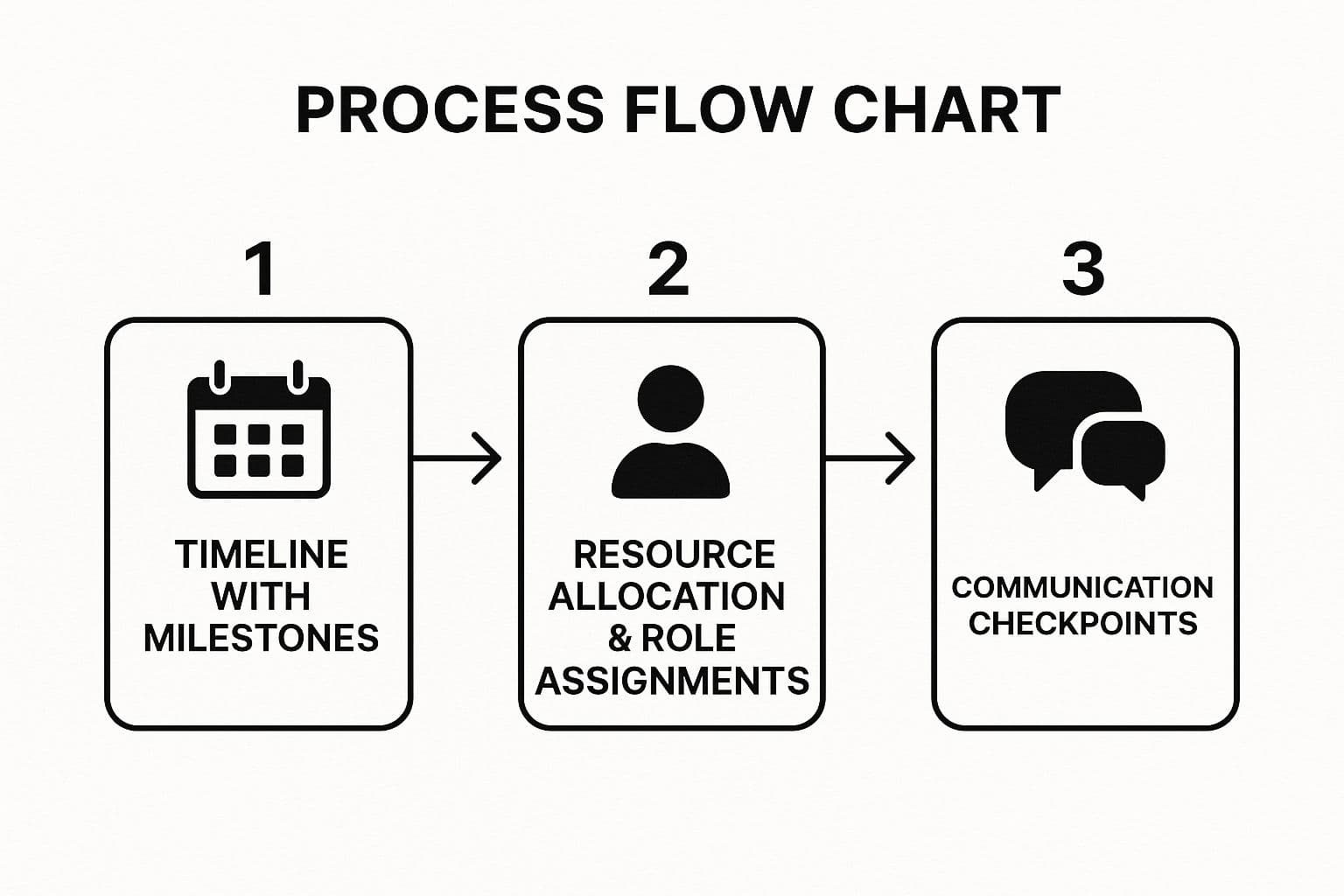Don't start your next project without this comprehensive project manager checklist. Master 8 essential steps from scope to closure for guaranteed success.
October 13, 2025 (1mo ago)
The Ultimate Project Manager Checklist: 8 Steps for 2025
Don't start your next project without this comprehensive project manager checklist. Master 8 essential steps from scope to closure for guaranteed success.
← Back to blog
In the wild world of project management, success is something you build, not something that just happens. Whether you're launching a new software feature or wrangling a big marketing campaign, the road from idea to reality is packed with tasks, tough calls, and things that can go wrong. The difference between a project that flies and one that flops often comes down to having a solid system. This is where a good project manager checklist** becomes your best friend.
This isn't just another to-do list; it's a strategic game plan that makes sure nothing critical gets missed, from nailing down the scope at the start to celebrating the win at the end. A solid checklist brings order to chaos, gets everyone on the same page, and helps you spot risks before they blow up. It turns you from a firefighter into a strategist.
This guide breaks down the project lifecycle into eight must-have checklist items, giving you practical tips to handle each phase like a pro. We'll cover everything from planning and stakeholder politics to smart tracking and wrapping things up right. By following this project manager checklist, you’ll learn how to stay in control, work smarter, and consistently deliver results that actually matter.
1. Define Project Scope and Objectives
Setting clear boundaries, deliverables, and measurable goals is the absolute bedrock of any successful project. A well-defined scope is like your project's constitution; it spells out exactly what you will and won't deliver. This crucial first step gets all the key players aligned on a shared vision and gives you a rock-solid reference point for every decision down the line, saving you from the dreaded "scope creep" that tanks timelines and budgets.

Without this clarity, teams are just guessing, which usually leads to rework, missed deadlines, and unhappy stakeholders. The Sydney Opera House is a classic cautionary tale where a fuzzy initial scope led to a 10-year delay and a budget that ballooned by over 1,400%. This is the first and most important item on any project manager checklist because everything else—from assigning resources to managing risks—is built on a solid scope.
How to Implement This Step
Start by getting all the key stakeholders in a room—the sponsor, team leads, and a few end-users—for a dedicated scope meeting. Your job is to turn their big-picture business needs into specific, tangible project outcomes.
- Document Inclusions and Exclusions: Make a clear list of everything the project will deliver. Just as important, create an "out of scope" list to manage expectations and stop people from assuming extra features are included.
- Define Success Criteria: Use the SMART framework (Specific, Measurable, Achievable, Relevant, Time-bound) to set clear goals. Instead of a vague "improve user experience," a SMART goal would be "Reduce user clicks to complete a purchase by 25% within Q3."
- Create a Scope Baseline: Get the agreed-upon scope written down in a formal document and have the project sponsor sign off on it. This document becomes the official measuring stick for any proposed changes.
- Establish a Change Control Process: No project is immune to change. Set up a formal process for how change requests will be submitted, reviewed, and approved so you can stay in control.
2. Create Comprehensive Project Plan
If the scope is the constitution, the project plan is the detailed playbook that governs your day-to-day. This roadmap is a living document that spells out exactly how the project will be executed, monitored, and controlled. It breaks down the scope into a real schedule, assigns resources, and sets key milestones. It’s the one-stop shop for the entire team and the baseline you'll measure all your progress against.

Without a detailed plan, a project is just a bunch of good intentions. Think about the London 2012 Olympics—they successfully coordinated over 20,000 activities and finished on time because they had a ridiculously detailed plan. This step is a must-have on any project manager checklist because it turns the "what" and "why" from your scope into the "how," "who," and "when" of getting things done, giving everyone on the team clear direction.
How to Implement This Step
Building the project plan isn't a solo job. It's a team effort that needs input from everyone to make sure it's accurate and gets people on board. The plan should be detailed enough to guide the team but flexible enough to handle a few curveballs. For a deeper dive, you can learn more about how to build a robust project plan.
- Develop a Detailed Schedule: Use tools like Gantt charts to map out the project timeline. Break down big deliverables into smaller tasks, guess how long they'll take, and figure out which tasks depend on others.
- Allocate Resources: Assign people to specific tasks based on their skills and availability. Make a list of everything you'll need, including people, money, and equipment.
- Establish Milestones and Baselines: Define key project milestones that mark major achievements. Set baselines for your schedule, cost, and scope so you can track how you're doing and spot any deviations.
- Plan for Communication: Create a communication plan that outlines how, when, and to whom project info will be shared. This keeps all your stakeholders in the loop and on your side.
3. Identify and Manage Stakeholders
A project’s success rarely comes down to just the project team; it depends on getting support, influence, and buy-in from a whole network of people. Methodically identifying and managing stakeholders—from your top sponsor to the end-users—is key to navigating the messy human side of any project. It’s all about figuring out who cares about your project, understanding what they want, and coming up with a plan to keep them engaged, turning potential roadblocks into your biggest fans.
Ignoring this step can be a disaster. The initial launch of Healthcare.gov is a perfect example of what happens with bad stakeholder communication. A lack of coordination between government agencies, contractors, and other key groups led to a very public failure. This item is a cornerstone of any project manager checklist because, at the end of the day, people deliver results, not processes. Good stakeholder management keeps everyone aligned, reduces resistance, and builds a coalition of support that can get a project through the tough spots.
How to Implement This Step
Start with a brainstorming session with your core team to list out every single person, group, or company that could be affected by or have influence over the project. Once you have that list, you can start analyzing and planning your strategy.
- Conduct a Stakeholder Analysis: Map each stakeholder on an influence/interest grid to figure out where to focus your energy. This helps you spend your time on the people who can make or break your project.
- Develop a Communication Plan: Tailor your communication for different stakeholder groups. High-influence folks might need regular one-on-one meetings, while others can be kept in the loop with a monthly newsletter. Effective engagement is all about good communication, and you can learn more about how to improve communication skills in the workplace.
- Use a RACI Matrix: To avoid confusion, use a RACI (Responsible, Accountable, Consulted, Informed) matrix to clearly define who does what. It spells out roles and responsibilities for each stakeholder in relation to project tasks.
- Engage Both Supporters and Blockers: Be proactive and identify people who might push back against the project. Talk to them to understand their concerns, address their issues head-on, and try to win them over—or at least neutralize their opposition.
4. Establish Risk Management Process
Thinking about risks ahead of time turns uncertainty from a scary threat into something you can actually manage. It's about systematically spotting, analyzing, and responding to potential things that could impact your project, for better or for worse. The goal isn't to eliminate every single risk—that's impossible—but to make your project resilient enough to handle bumps in the road and even grab unexpected opportunities.
Skipping this step is basically just gambling with your project's success. The tragic Boeing 737 MAX crisis is a harsh reminder of what happens when risk assessment goes wrong, with engineering and software risks being tragically underestimated. On the flip side, Toyota's solid supply chain risk management helped them bounce back incredibly fast after the 2011 Japanese earthquake. A formal risk process is a non-negotiable part of any professional project manager checklist because it gives you the foresight to handle complexity and deliver on your promises. A strong process proves the ROI of proactive risk detection by cutting down on costly surprises.
How to Implement This Step
Start by making risk management a team effort, not just your job. A diverse group of people will spot a wider range of potential risks. Set up dedicated risk workshops during the planning phase and make it a regular topic of conversation throughout the project.
- Create a Risk Register: This is your master document for tracking all identified risks. For each risk, it should include a description, its potential impact, the likelihood of it happening, a response plan, and who's in charge of it.
- Prioritize Using a Matrix: Not all risks are created equal. Use a probability and impact matrix to sort risks from low to high severity. This helps you focus your attention and resources where they're needed most.
- Assign Clear Ownership: Every risk needs a designated "risk owner" who is responsible for keeping an eye on it and putting the response plan into action if it happens. This creates clear accountability.
- Develop Response Strategies: For each major risk, figure out a clear response plan. This could mean avoiding the risk (changing the plan to get rid of it), mitigating it (reducing its likelihood or impact), transferring it (like with insurance), or accepting it (for low-impact risks).
5. Assemble and Manage Project Team
A project's success is completely tied to the people doing the work. Putting together a skilled team is only half the job; the real trick is creating an environment where people feel they can collaborate, be accountable, and speak up without fear. This step is about picking the right people, defining clear roles, and actively managing team dynamics to keep everyone aligned and motivated from start to finish.

Without a team that clicks, even the best-laid plans will fall apart. Google's massive study, Project Aristotle, found that the single biggest factor in a team's success wasn't individual talent but psychological safety—the shared belief that it's safe to take risks and be vulnerable in front of each other. This shows why proactive team management is a non-negotiable on any project manager checklist; a tight-knit team can tackle anything, while a dysfunctional one will just create more problems.
How to Implement This Step
Start by matching team skills and roles to what the project actually needs, as laid out in your scope. From there, your focus should be on building and maintaining a positive and productive team culture.
- Host a Formal Kickoff Meeting: Use this meeting to get everyone on the same page about the project's vision, goals, and what success looks like. Clearly spell out everyone's roles, responsibilities, and who has the authority to make decisions to avoid confusion from day one.
- Establish Communication Rhythms: Set up regular, structured check-ins, like daily stand-ups for agile teams or weekly meetings for traditional projects. This keeps everyone in sync and helps you spot roadblocks early.
- Foster Psychological Safety: Encourage open conversation, active listening, and constructive feedback. Deal with conflicts quickly and directly before they get worse, creating a culture where people feel respected and heard.
- Celebrate and Develop: Acknowledge and celebrate milestones to keep morale and momentum high. Invest in your team's growth by giving them opportunities to build skills that are relevant to the project.
6. Implement Progress Tracking and Reporting
A project plan is just a guess about the future; tracking and reporting are what turn that guess into reality. This step involves setting up systematic ways to monitor how the project is doing against your baseline, measure progress toward your goals, and share updates transparently with all stakeholders. Without a good tracking system, a project manager is flying blind, unable to see problems until they’re too big to fix.

Dropping the ball here is a surefire way to blow your budget, miss deadlines, and blindside stakeholders. Agile teams, for instance, live by their burndown charts for daily visibility into a sprint's progress, while NASA missions use intense tracking with multiple checkpoints to ensure every single piece is on schedule and up to spec. This constant oversight allows you to make adjustments proactively instead of just reacting to crises, making it a vital piece of any project manager checklist.
How to Implement This Step
Start by defining your key performance indicators (KPIs) during the planning phase, making sure they tie directly to the project's goals. Your tracking system should be the one and only source of truth for all project data to prevent confusion from conflicting reports.
- Establish a Reporting Cadence: Decide how often you'll send out reports (daily, weekly, monthly) based on the project's speed and risk level. A fast-moving software sprint needs more frequent updates than a long-term construction project.
- Use Visual Dashboards: Use tools that give you a quick visual summary of the project's health. Traffic light indicators (Red, Amber, Green) are great for executive summaries to quickly show status without getting bogged down in details.
- Track Variances: Don't just report on what's done. Analyze the difference between your plan and your actual progress, cost, and schedule. Techniques like Earned Value Management (EVM) can help you forecast future performance.
- Tailor Reports to the Audience: Create different versions of status reports for different people. Executives might just need a high-level summary, while the project team needs detailed, task-level updates.
7. Manage Change Control Process
Change is going to happen in any project, but uncontrolled change is a top reason projects fail. A formal change control process is your structured system for handling adjustments to the project's scope, timeline, or budget. It makes sure that every proposed change is carefully looked at for its impact, approved by the right people, and rolled out in a way that doesn't wreck the project. This system is what stops that chaotic "scope creep" from eating away at your plans and jeopardizing success.
Without a formal process, projects are vulnerable to every new idea or stakeholder whim, leading to confusion, rework, and blown budgets. The epic failure of the Denver Airport's automated baggage system is a stark reminder of this. Uncontrolled scope changes were a huge factor in its 16-month delay and cost overrun of more than $560 million. This step is a non-negotiable part of any serious project manager checklist because it gives you the stability to handle change without letting it derail your project's main goals.
How to Implement This Step
Set up a clear, transparent, and consistent process right from the start. This system needs to be understood and respected by all stakeholders, creating a predictable way to adapt when needed while protecting the project from random changes.
- Establish a Change Control Board (CCB): Designate a group of key stakeholders, like the project sponsor and team leads, who have the authority to review and approve or reject change requests.
- Use a Standardized Change Request Form: Create a template that forces people to detail the proposed change, explain why it's needed, and what its benefits are. This makes sure you have all the info you need to do a proper impact assessment.
- Conduct a Thorough Impact Analysis: For every request, your team has to analyze how it could affect the project's scope, schedule, budget, resources, and risks. This data is what the CCB needs to make an informed decision.
- Communicate and Document All Decisions: Once a decision is made, tell everyone affected. If a change is approved, update all the relevant project documents—the scope statement, project plan, and schedule—to reflect the new baseline.
8. Conduct Project Closure and Lessons Learned
Getting the work done is just one part of finishing a project; a formal closure is what really lets you bank the value and avoid future problems. Project closure is the systematic process of wrapping up all activities, getting formal sign-off on the deliverables, and letting the project team go. It's a phase that often gets skipped, but it's what separates good project managers from great ones, as it ensures that valuable knowledge gets captured for the whole company, not lost when the team moves on.
Skipping this final step is like running a marathon and stopping one foot short of the finish line. It leaves loose ends, like open contracts or undocumented lessons, that can create risks later on. NASA’s intense post-mission reviews are a powerful example of this in action. Every flight, whether it was a success or not, provides critical data to make future missions better. This final item on the project manager checklist makes sure the project’s legacy helps the organization get smarter and continuously improve.
How to Implement This Step
The closure phase should be planned from the get-go, not treated as an afterthought. It needs a structured approach to make sure all the administrative, contractual, and knowledge-sharing tasks get done right.
- Gain Formal Acceptance: Get written sign-off on the final deliverables from the client or project sponsor. This officially confirms that the project met its goals and delivered on the scope.
- Host a Lessons Learned Session: Schedule a retrospective meeting while the project is still fresh in everyone’s mind. Use a simple framework like Start-Stop-Continue to have a blameless discussion about what went well and what could be done better next time.
- Archive Project Documentation: Gather all your project documents—plans, reports, contracts, change logs—and stick them in a central, accessible place. This archive becomes a goldmine for future project teams.
- Release Resources and Celebrate: Formally release your project team members and give them feedback on their performance. And don't forget to acknowledge the team’s hard work and celebrate the win. It’s great for morale and builds a positive project culture.
Project Manager Checklist: 8 Key Task Comparison
| Project Phase | Implementation Complexity 🔄 | Resource Requirements ⚡ | Expected Outcomes 📊 | Ideal Use Cases 💡 | Key Advantages ⭐ |
|---|---|---|---|---|---|
| Define Project Scope and Objectives | Medium - upfront time, stakeholder input needed | Moderate - meetings, documentation | Clear boundaries, prevents scope creep, measurable goals | Early project stage, defining deliverables | Reduces conflicts, sets clear direction and success criteria |
| Create Comprehensive Project Plan | High - detailed schedules, risk, and communication plans | High - tools, team effort, frequent updates | Structured roadmap, resource optimization, transparency | Complex projects needing tight control | Proactive problem solving, accountability, milestone tracking |
| Identify and Manage Stakeholders | Medium - analysis and customized engagement | Moderate - relationship management effort | Improved support, expectation alignment, issue identification | Projects with many or diverse stakeholders | Minimizes resistance, improves decisions, resource acquisition |
| Establish Risk Management Process | Medium - ongoing identification and assessment | Moderate - workshops, monitoring tools | Reduced surprises, informed decision-making, contingency plans | High-risk or complex environments | Builds confidence, identifies opportunities, proactive management |
| Assemble and Manage Project Team | Medium to High - selection, training, conflict resolution | High - HR time, team activities | Motivated, cohesive team delivering quality work | Projects relying on skilled collaboration | Better communication, adaptability, faster delivery |
| Implement Progress Tracking & Reporting | Medium - KPI definition, data collection, regular updates | Moderate - tools and reporting effort | Early problem detection, data-driven decisions, transparency | Any project requiring ongoing monitoring | Maintains confidence, objective health assessment |
| Manage Change Control Process | Medium - formal process, impact analysis | Moderate - documentation, approval workflow | Controlled change, baseline integrity, audit trail | Projects prone to scope or requirement changes | Balances flexibility with control, prevents scope creep |
| Conduct Project Closure & Lessons Learned | Low to Medium - final documentation and workshops | Low to Moderate - meetings, archiving | Formal closure, knowledge capture, success evaluation | End of project phase, continuous improvement focus | Ensures completion, organizational learning, stakeholder closure |
From Checklist to Execution: Your Next Steps
Going from a solid project manager checklist to actually pulling it off flawlessly is the real challenge for any project leader. The eight pillars we've talked about—from defining scope and managing stakeholders to handling change control and closing out a project properly—aren't just a list of things to do. They're a dynamic framework for turning a great idea into a real, successful outcome. This checklist is your blueprint, but the real magic is in how you use it.
Mastering these stages means you stop being a reactive problem-solver and start being a proactive, strategic leader. Instead of just putting out fires, you’re preventing them by setting up a solid risk management process from day one. Instead of fighting scope creep, you have a formal change control process that helps you make smart decisions. This is the difference between just managing a project and truly leading it with confidence.
Making the Checklist Your Command Center
The real power of this project manager checklist comes when it's just part of how you work every day, not some document you look at once and then forget. To make that happen, here are a few things you can do:
- Audit Your Current Process: Be honest and look at your last project. Where did things go well, and where were the headaches? Compare those experiences to the eight checklist items. Did a lack of stakeholder management cause a bottleneck? Did a fuzzy scope lead to a bunch of rework? Use this to spot your biggest areas for improvement.
- Implement One New Habit at a Time: Don't try to change everything at once. Pick one area from the checklist to focus on for your next project. For example, spend extra time creating a more detailed project plan or formalize how you track and report progress. Once that becomes second nature, move on to the next one.
- Foster a Culture of Continuous Learning: Project management is always changing. As you use these steps, think about your own professional growth. Looking into resources for understanding a junior project manager career can give you fresh ideas and solid fundamentals, helping you and your team sharpen your skills.
Ultimately, this checklist is more than a guide; it’s a tool for building repeatable success. By consistently using these principles, you create a predictable structure that frees you up to focus on what really matters: delivering amazing value, empowering your team, and hitting your goals with more efficiency and less stress. You build the systems that let your projects, and your career, truly shine.
Ready to turn your checklist into a seamless, automated workflow? Fluidwave provides an integrated platform to manage every item on this list, from initial planning to final reporting, all in one distraction-free environment. Transform your project management and start delivering results with clarity and control.
Focus on What Matters.
Experience lightning-fast task management with AI-powered workflows. Our automation helps busy professionals save 4+ hours weekly.